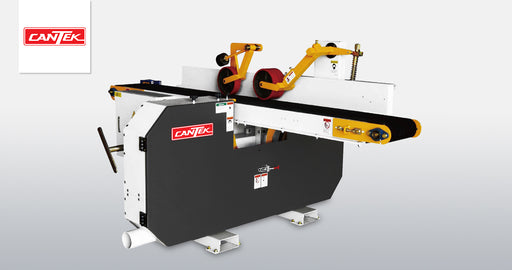A horizontal resaw is a woodworking machine designed to make horizontal cuts through large wooden boards or panels, producing thinner slices or boards with consistent thickness. Its primary function is to maximize lumber yield by efficiently dividing thick stock into multiple thinner pieces, suitable for further processing or assembly.
Key Features of a Horizontal Resaw
Wide Cutting Capacity: Horizontal resaws feature wide cutting capacities to accommodate large wooden boards or panels, allowing for efficient processing of various wood species and sizes.
Adjustable Blade Height and Tension: Many machines offer adjustable blade height and tension settings to optimize cutting performance and ensure straight, uniform cuts across the entire width of the stock.
Variable Feed Speed: Some resaws come with variable feed speed control features, allowing operators to adjust the rate at which the stock is fed through the blade, optimizing cutting efficiency and finish quality.
Blade Guides and Guards: Horizontal resaws are equipped with blade guides and guards to support and protect the cutting blade, minimizing vibration and ensuring safe operation during cutting operations.
Dust Collection System: Certain models feature integrated dust collection systems or ports to capture sawdust and debris generated during cutting, maintaining a clean and safe working environment.
Applications of Horizontal Resaws
Lumber Processing: Horizontal resaws are commonly used in sawmills and lumber yards to convert large timber logs into thinner boards or planks for various woodworking applications, such as furniture making, construction, and flooring.
Veneer Production: Woodworkers utilize horizontal resaws to slice thin veneer sheets from hardwood logs or blocks, providing a cost-effective and efficient method for producing decorative veneers used in cabinetry, millwork, and architectural applications.
Panel Production: Horizontal resaws are employed in panel processing facilities to cut large wooden panels or sheets into thinner panels with consistent thickness for manufacturing plywood, laminates, and engineered wood products.
Timber Re-Sizing: Woodshops use horizontal resaws to resize or resaw reclaimed lumber, salvaged beams, or oversized stock into smaller, more manageable pieces for woodworking projects, renovations, or custom millwork.
Choosing the Right Horizontal Resaw
Cutting Capacity: Consider the cutting capacity of the horizontal resaw, including maximum cutting width and depth, to ensure it can accommodate the size and thickness of the stock you typically work with.
Blade Quality and Size: Evaluate the quality and size of the cutting blade, including tooth configuration and material composition, to ensure it can withstand the rigors of cutting various wood species and provide clean, accurate cuts.
Feed System: Look for a resaw with a reliable and efficient feed system, such as powered rollers or belts, to ensure smooth and consistent stock feeding during cutting operations, minimizing waste and maximizing productivity.
Blade Guides and Guards: Choose a machine with robust blade guides and guards to provide stability and safety during cutting, reducing blade deflection and minimizing the risk of accidents or injuries.






